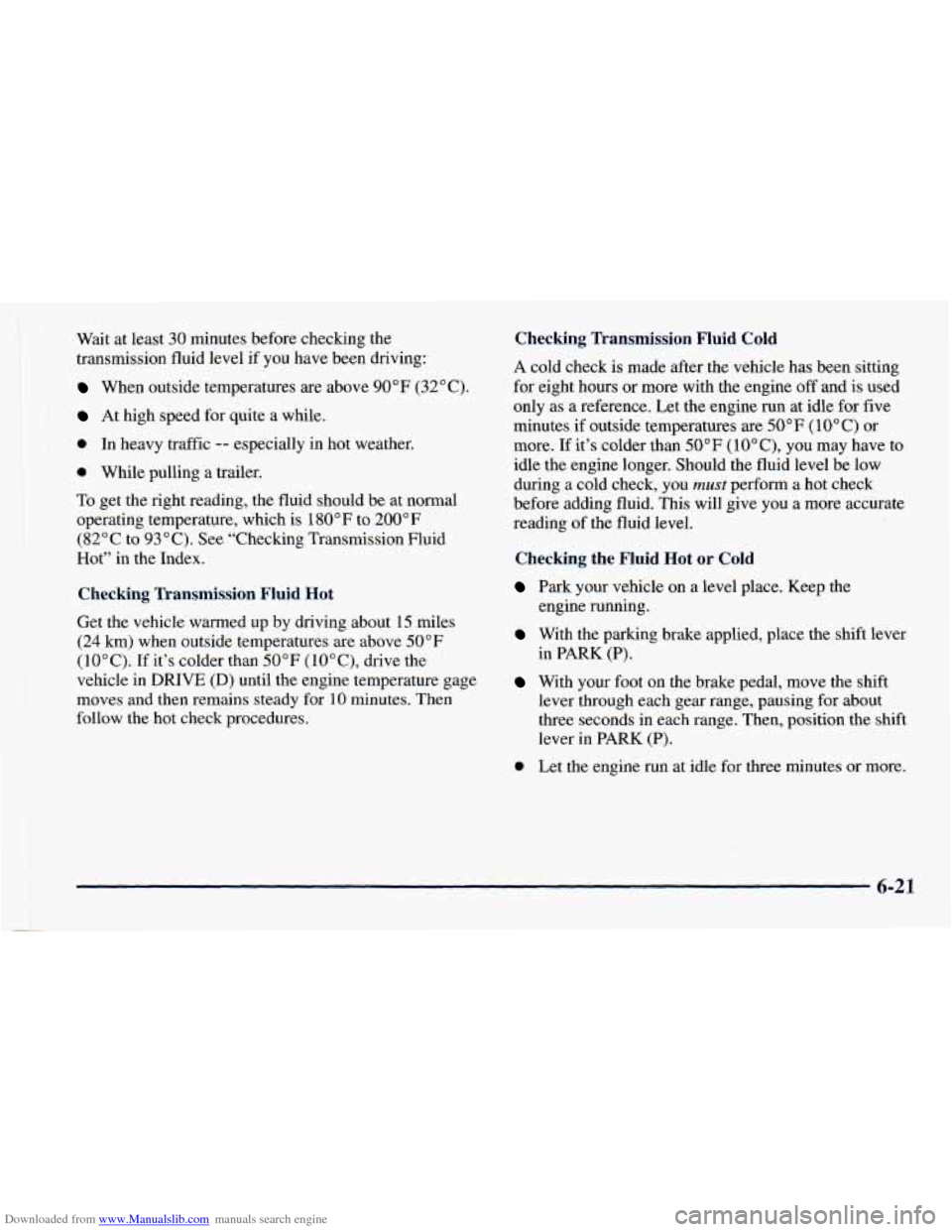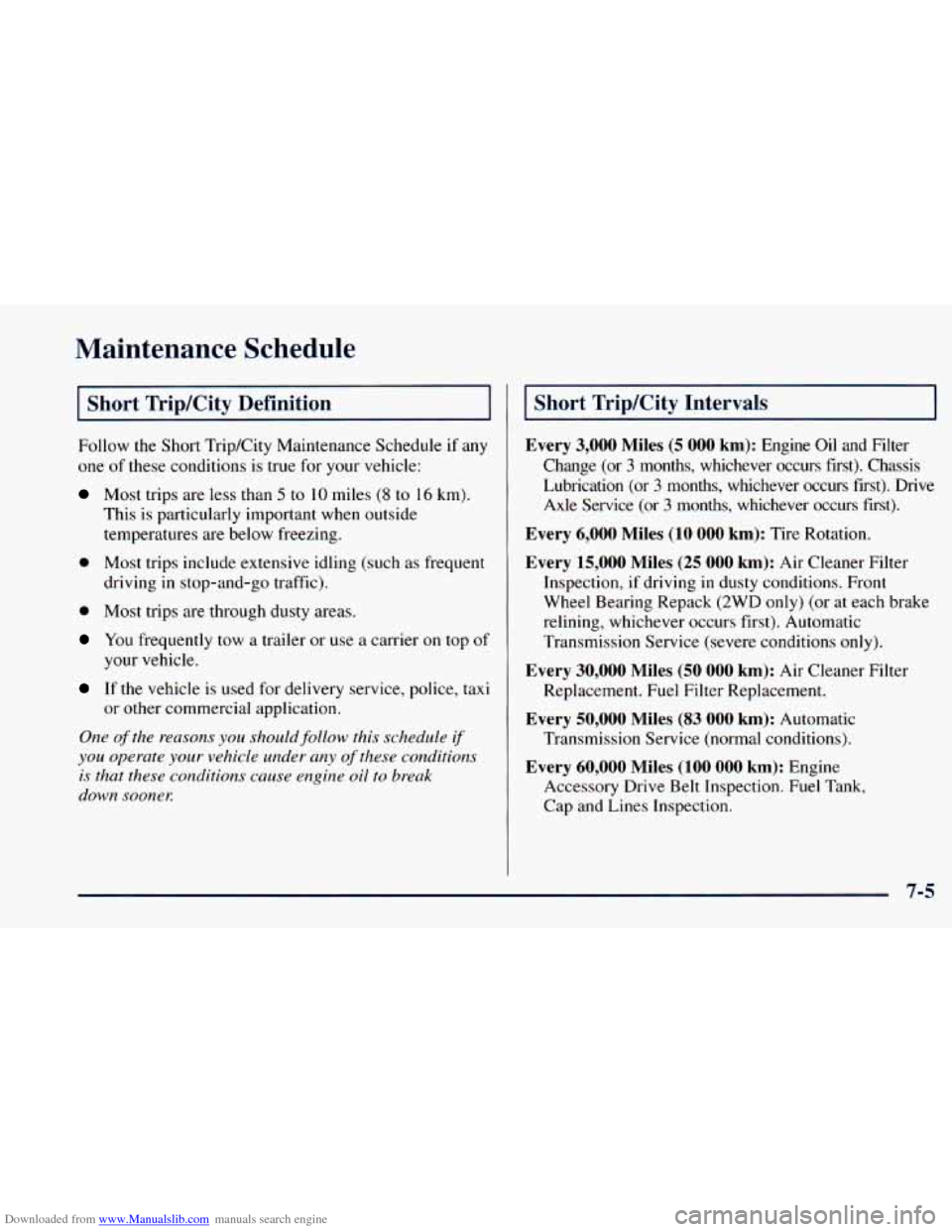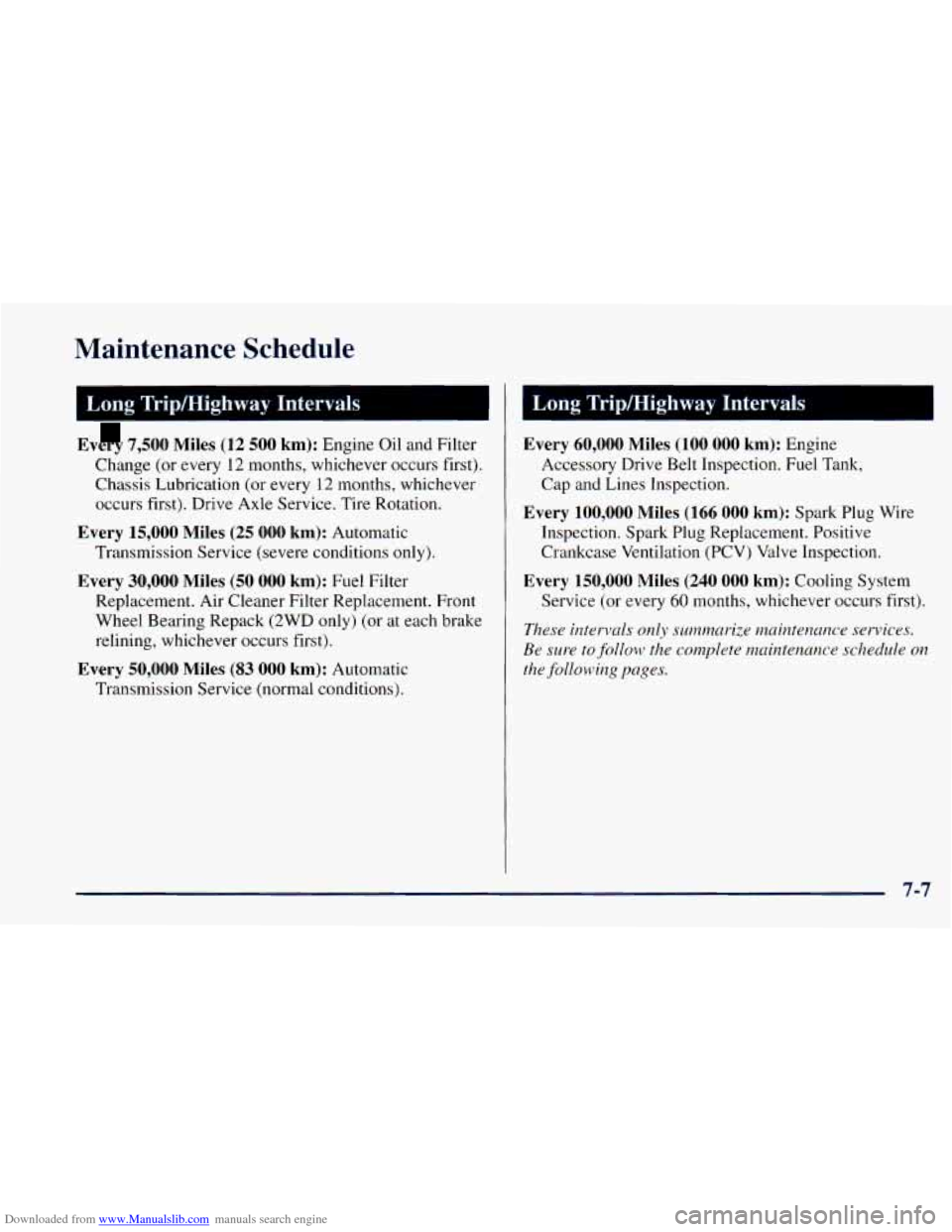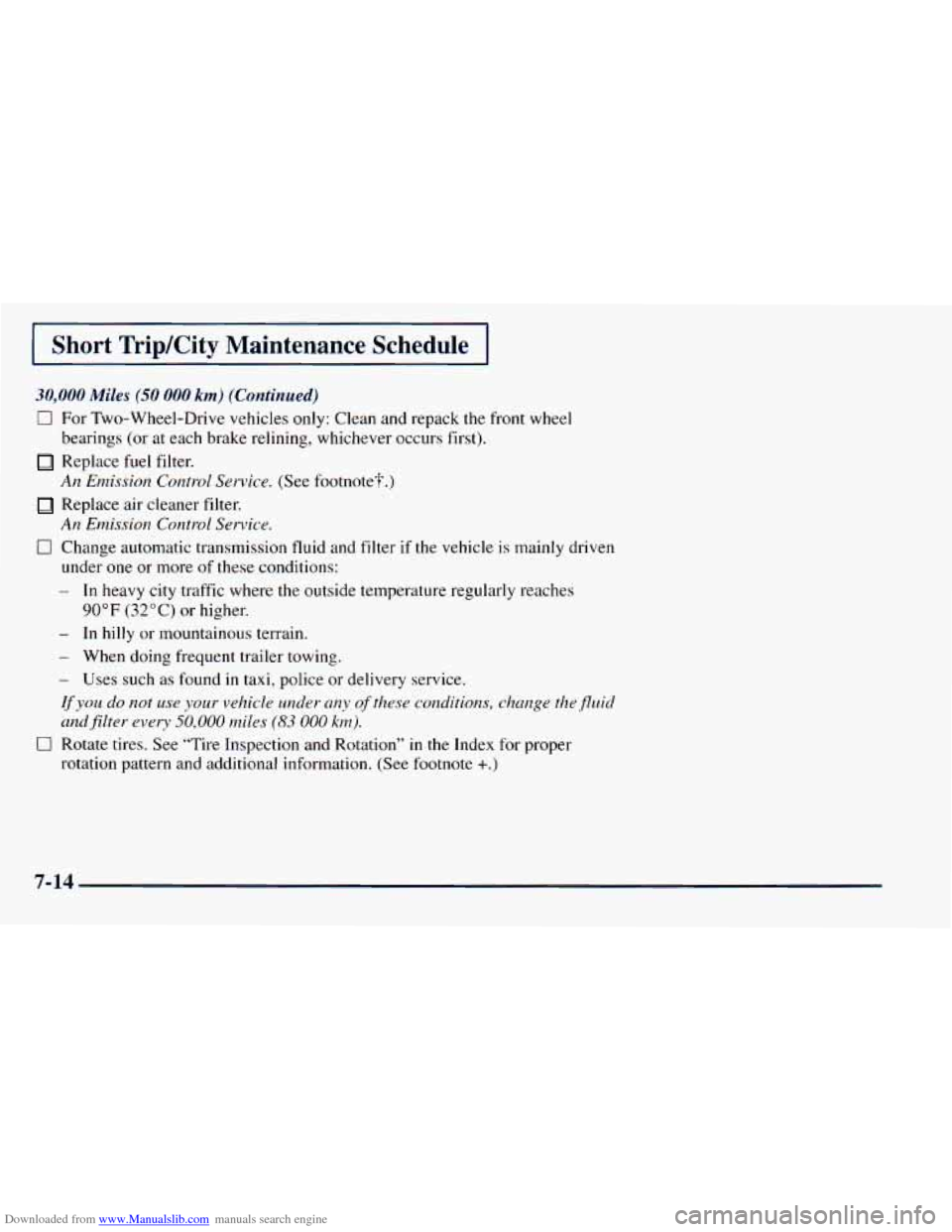Page 283 of 414

Downloaded from www.Manualslib.com manuals search engine I
’Wait at least 30 minutes before checking the
transmission fluid level if you have been driving:
When outside temperatures are above 90°F (32°C).
At high speed for quite a while.
0 In heavy traffic -- especially in hot weather.
0 While pulling a trailer.
To get the right reading, the fluid should be at normal
operating temperature, which
is 180°F to 200°F
182°C to 93 ” C). See “Checking Transmission Fluid
’Hot” in the Index.
Checking Transmission Fluid Hot
Get the vehicle warmed up by driving about 15 miles
(24 km) when outside temperatures are above 50°F
(10°C). If it’s colder than 50°F (lO”C), drive the
vehicle in DRIVE
(D) until the engine temperature gage
moves and then remains steady for
10 minutes. Then
follow the hot check procedures.
Checking Transmission Fluid Cold
A cold check is made after the vehicle has been sitting
for eight hours or more with the engine off and is used
only as a reference. Let the engine run at idle for five
minutes
if outside temperatures are 50°F (10°C) or
more. If it’s colder than
50°F ( 10°C), you may have to
idle the engine longer. Should the fluid level be low
during
a cold check, you must perform a hot check
before adding fluid. This will give you a more accurate
reading
of the fluid level.
Checking the Fluid Hot or Cold
Park your vehicle on a level place. Keep the
engine running.
With the parking brake applied, place the shift lever
in PARK (P)
.
With your foot on the brake pedal, move the shift
lever through each gear range, pausing for about
three seconds in each range. Then, position the shift
lever in
PARK (P).
0 Let the engine run at idle for three minutes or more.
6-21
Page 284 of 414
Downloaded from www.Manualslib.com manuals search engine I
Then, without shutting off the engine, follow these steps:
The transmission dipstick has a red handle and
is located near
the center of the engine compartment behind the air cleaner.
1. Flip the handle up and then pull out the dipstick and
wipe it with a clean rag or paper towel.
then pull it back out again.
2. Push it back in all the way, wait three seconds and
3. Check both sides of the dipstick, and read the lower
level. The fluid level must be in the
COLD area for a
cold check or in the
HOT area or cross-hatched area
for a hot check.
4. If the fluid level is in the acceptable range, push the
dipstick back
in all the way; then flip the handle
down to lock the dipstick in place.
6-22
Page 285 of 414

Downloaded from www.Manualslib.com manuals search engine How to Add Fluid
Refer to the Maintenance Schedule to determine what
kind of transmission fluid to use. See “Recommended
Fluids and Lubricants” in the Index.
Add fluid
only after checking the transmission fluid
while it is hot. (A cold check is used
only as a
reference.) If the fluid level is low, add only enough of
the proper fluid to bring the level up to the HOT area for
a hot check. It doesn’t take much fluid, generally less
than one pint
(0.5 L). Don’t overji11.
NOTICE:
We recommend you use only fluid labeled
DEXRON@-111, because fluid with that label is
made especially for your automatic transmission.
Damage caused by fluid other than DEXRON-I11
is not covered by your new vehicle warranty.
After adding fluid, recheck the fluid level as
described under “How
to Check.”
When the correct fluid level is obtained, push the
dipstick back in
all the way; then flip the handle
down to lock the dipstick in place.
All-Wheel Drive
If you have an all-wheel-drive vehicle, be sure to
perform
the lubricant checks described in this section.
However, they have two additional systems that
need lubrication.
Transfer Case
When to Check Lubricant
Refer to the Maintenance Schedule to determine how
often to check
the lubricant. See “Periodic Maintenance
Inspections” in the Index.
6-23
Page 329 of 414

Downloaded from www.Manualslib.com manuals search engine Capacities and Specifications
All capacities are approximate. English and metric
conversions are given.
Please refer to “Recommended Fluids and Lubricants”
in the Index for more information.
Engine Specifications
Engine .............. “VORTEC” 4300 V6 CSFI*
RPO
................................. L35
Firing Order
...................... 1-6-5-4-3-2
Thermostat Specification
........... 195 OF (9 1 O C)
Horsepower
................... 190 at
4,400 rpm
*Central Sequential
Fuel Injection
Wheel Nut Torque
Tire Pressures ........ See “Loading Your Vehicle”
Base
or Optional Wheel ....... 100 lb-ft
(140 N-m)
in the Index.
Cooling System Capacity
Quantity” Quantity”
without Rear Heater with Rear Heater
13.5 quarts (12.8 L) 16.5 quarts (15.6 L)
After refill, the level
must be checked,
* All quantities are approximate.
Crankcase Capacity
Quantity”
with Filter
..... ........... 4.5 quarts (4.3 L)
After refill, the level
must be checked. Do not overfill.
* All quantities are approximate.
Fuel Tank Capacity
Standard Tank ................ .25 gallons (90 L)
Transmission Capacity
Automatic Transmission
(Drain and Refill)
............ 5.0 quarts (4.7 L)
Front Axle Capacity
Front Axle .......... . . 2.6 pint (1.2 L)
6-67
Page 339 of 414

Downloaded from www.Manualslib.com manuals search engine Maintenance Schedule
I Short Trip/City Definition
Follow the Short Trip/City Maintenance Schedule if any
one of these conditions
is true for your vehicle:
Most trips are less than 5 to 10 miles (8 to 16 km).
This is particularly important when outside
temperatures are below freezing.
driving
in stop-and-go traffic).
0 Most trips are through dusty areas.
You frequently tow a trailer or use a carrier on top of
If the vehicle is used for delivery service, police, taxi
One of the reasons you should follow this schedule if
you operate your vehicle under any of these conditions
is that these conditions cause engine oil to
break
down sooneE
0 Most trips include extensive idling (such as frequent
your vehicle.
or other commercial application.
I Short Trip/City Intervals
Every 3,000 Miles (5 000 km): Engine Oil and Filter
Change (or
3 months, whichever occurs first). Chassis
Lubrication (or
3 months, whichever occurs first). Drive
Axle Service (or
3 months, whichever occurs first).
Every 6,000 Miles (10 000 km): Tire Rotation.
Every 15,000 Miles (25 000 km): Air Cleaner Filter
Inspection, if driving
in dusty conditions. Front
Wheel Bearing Repack
(2WD only) (or at each brake
relining, whichever occurs first). Automatic
Transmission Service (severe conditions only).
Every 30,000 Miles (50 000 km): Air Cleaner Filter
Replacement. Fuel Filter Replacement.
Every 50,000 Miles (83 000 km): Automatic
Transmission Service (normal conditions).
Every 60,000 Miles (100 000 km): Engine
Accessory Drive Belt Inspection. Fuel Tank,
Cap and Lines Inspection.
7-5
Page 341 of 414

Downloaded from www.Manualslib.com manuals search engine Maintenance Schedule
L Long Tripmighway Intervals I
Every 7,500 Miles (12 500 km): Engine Oil and Filter
Change (or every 12 months, whichever occurs first).
Chassis Lubrication
(or every 12 months, whichever
occurs first). Drive Axle Service. Tire Rotation.
Every 15,000 Miles (25 000 km): Automatic
Every 30,000 Miles (50 000 km): Fuel Filter
Transmission Service (severe conditions
only).
Replacement.
Air Cleaner Filter Replacement. Front
Wheel Bearing Repack
(2WD only) (or at each brake
relining, whichever occurs first).
Every 50,000 Miles (83 000 km): Automatic
Transmission Service (normal conditions).
Long Tripmighway Intervals
Every 60,000 Miles (100 000 km): Engine
Accessory Drive Belt Inspection.
Fuel Tank,
Cap and Lines Inspection.
Inspection. Spark Plug Replacement. Positive
Crankcase Ventilation (PCV) Valve Inspection.
Every 150,000 Miles (240 000 km): Cooling System
Service (or every
60 months, whichever occurs first).
These intervals only summarize maintenance services.
Be sure to follow the complete maintenance schedule on
the following pages.
Every 100,000 Miles (166 000 km): Spark Plug Wire
7-7
Page 345 of 414

Downloaded from www.Manualslib.com manuals search engine 1 Short TripKity Maintenance Schedule I
0 Inspect air cleaner filter if you are driving in dusty conditions. Replace filter
if necessary.
An Emission Control Service. (See footnote?.)
velocity joints and axle seals for leaking. (See footnote
**.)
bearings (or at each brake relining, whichever occurs first).
under
one or more of these conditions:
0 Check readfront axle fluid level and add fluid as needed. Check constant
0 For Two-Wheel-Drive vehicles only: Clean and repack the front wheel
0 Change automatic transmission fluid and filter if the vehicle is mainly driven
- In heavy city traffic where the outside temperature regularly reaches
- In hilly or mountainous terrain.
- When doing frequent trailer towing.
90 OF (32 O C) or higher.
- Uses such as found in taxi, police or delivery service.
If you do not use yaw- vehicle under any of these conditions, change thejiruid
andfilter every
50,000 miles (83 000 km).
18,000 Miles (30 000 km)
0 Change engine oil and filter (or every 3 months, whichever occurs first).
An Emission Control Service.
7-11
Page 348 of 414

Downloaded from www.Manualslib.com manuals search engine I Short TripKity Maintenance Schedule I
30,000 Miles (50 000 km) (Continued)
0
0
0
For Two-Wheel-Drive vehicles only: Clean and repack the front wheel
bearings (or at each brake relining, whichever occurs first).
Replace
fuel filter.
An Emission Control Service. (See footnote+.)
Replace air cleaner filter.
An Emission Control Service.
Change automatic transmission fluid and filter if the vehicle is mainly driven
under one or more of these conditions:
- In heavy city traffic where the outside temperature regularly reaches
- In hilly or mountainous terrain.
- When doing frequent trailer towing.
- Uses such as found in taxi, police or delivery service.
If you do not use your vehicle under any of these conditions, change the fluid
and.filter every
50,000 miles (83 000 km).
Rotate tires. See “Tire Inspection and Rotation” in the Index for proper
rotation pattern and additional information. (See footnote
+.)
90°F (32°C) or higher.
7-14